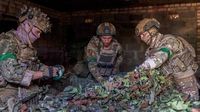On the battered frontlines of eastern Ukraine, where the thrum of Russian drones and the echo of artillery fire have become the soundtrack of daily life, a new kind of soldier is rolling into action. These aren’t men or women in uniform, but nimble, remote-controlled armored vehicles—what Ukrainian troops have come to call “robots on wheels.” As the war grinds into its fourth year and manpower shortages bite, these machines are increasingly taking on the most perilous jobs, ferrying supplies, clearing mines, and evacuating the wounded or the dead, all while keeping human lives out of the line of fire.
According to the Associated Press, the Ukrainian army’s embrace of these remote-controlled vehicles marks a significant shift in battlefield tactics. The vehicles, which resemble miniature tanks, are built by Ukrainian companies and range in cost from a modest $1,000 to as much as $64,000, depending on their size and capabilities. Along the sprawling 1,000-kilometer (620-mile) front line, their presence is now vital—especially as the pool of available soldiers continues to dwindle.
The machines themselves are a study in practicality and adaptation. Painted in drab military colors, they crawl across rubble-strewn roads or dirt tracks, navigating terrain that would be treacherous—or outright deadly—for any human. While they can’t fully replace the men and women on the front, they’re often deployed when the risk is just too great. As a platoon commander from the 20th Lyubart Brigade, known by the call sign Miami, put it: “It cannot fully replace people. I would put it this way: A person can go in there, but for a human it’s sometimes far too dangerous.”
Miami’s journey through the war mirrors the transformation of the conflict itself. Having joined the Ukrainian army on the very first day of Russia’s full-scale invasion in February 2022, he started as an infantryman, then became a drone operator, and now oversees the integration of these robotic vehicles into frontline operations. “War is progress, and we cannot stand aside,” he told Mid-day, underscoring how necessity and innovation have become inseparable on the battlefield.
These vehicles aren’t entirely new to warfare. The German army, for instance, used a remote-controlled miniature tank called the Goliath during World War II. In more recent decades, countries like the United States, Israel, Britain, and China have developed their own versions for combat engineering and other battlefield roles. What’s different about Ukraine’s effort, as noted by Ben Barry of the International Institute for Strategic Studies in London, is the scale and urgency of their deployment. Both Ukrainian and Russian forces now rely on remote-controlled vehicles, but Ukraine’s widespread use could drive new advances in their design and application.
In the shadow of Kostiantynivka—a city once home to 67,000 residents but now largely deserted and nearly encircled by Russian forces—the realities of modern warfare are on stark display. Apartment blocks are pockmarked by rocket strikes, smoke rises from recent bombings, and the roads are littered with the skeletal remains of burned-out vehicles. It’s here that Miami’s team, operating from a cramped basement less than 10 kilometers from the front, puts their “robots on wheels” through their paces.
The machines are armored and mounted on either wheels or tracks, and their controls have been customized to withstand Russian electronic warfare—a constant threat that can sever the connection between operator and vehicle in an instant. “They arrive in one condition, and we improve them,” Miami explained, describing how his unit adapts the vehicles’ controls to keep them operational even under electronic attack.
Currently, the vehicles are used mostly for delivering food and ammunition to soldiers near the front lines. But their potential is much greater, according to another soldier in Miami’s unit, who goes by the call sign Akim. “When FPV (first-person view) drones first appeared, they weren’t popular, but those who pioneered them now show the best results,” Akim told Associated Press. He believes that, just as drones have become indispensable, so too will these ground-based robots.
Before each mission, Akim uses a drone to scout the planned route, searching for obstacles or mines that could spell disaster for the remote-controlled vehicle. The robot itself has no onboard camera; instead, Akim’s drone provides its “eyes,” guiding it safely through the hazards of the battlefield. On a recent operation, the team loaded one of their vehicles with 200 kilograms (440 pounds) of supplies—everything from ammunition and fuel to water and food—and sent it several kilometers to a concealed post in the forest. The vehicle made the journey at about six kilometers per hour, delivered its cargo, and returned to base unscathed.
“Every time a drone or a robot does something, it means one of our fighters doesn’t have to,” Akim said, summing up the machines’ greatest benefit. “The machine doesn’t get tired. It can carry as much as needed.” The result is a reduction in risk and a conservation of precious human energy—a crucial advantage when every able-bodied soldier counts.
But the machines are not without their drawbacks. Their slow speed and tendency to cross open ground make them easy targets for enemy fire. “That’s why we haven’t evacuated many wounded on these vehicles,” Miami admitted. “Some refuse to leave because it’s dangerous.” The cost is another concern: with an average price tag of about 400,000 hryvnias ($9,700) per vehicle, the losses add up quickly when several are destroyed in a single week.
To counter these vulnerabilities, Miami’s team has experimented with modifications—welding grill-like cages onto the vehicles to provide extra protection, or attaching metallic rollers in front to detect and trigger mines before the vehicle itself is damaged. The war, with its relentless demands and constant dangers, acts as a real-time testing ground, and the lessons learned are quickly incorporated into the design of newer models.
Despite the challenges, the growing reliance on these robotic vehicles speaks volumes about Ukraine’s determination to adapt and survive. As the war continues to drag on, the ability to blend ingenuity with necessity may prove to be one of the country’s greatest strengths. Every robot that takes a risk, every drone that scouts a path, is one more chance for a soldier to live to fight another day.
In a conflict defined by attrition and innovation, Ukraine’s “robots on wheels” are quietly changing the rules of engagement—one mission, one life saved, at a time.





